Magnitude 6.1 Mw Date 26 July 1963 | Depth 6 kilometres (4 mi) | |
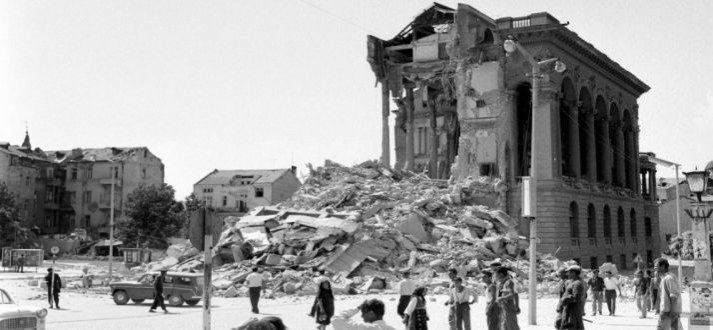 | ||
Areas affected Yugoslavia (mainly present-day Republic of Macedonia) Casualties 1,000–1,100 killedOther:macedonia skopje3,000–4,000 injured200,000 left homeless75–80% of city destroyed Similar 1979 Montenegro earthquake, 1969 Banja Luka earthquake, 1957 Andreanof Islands e, 1964 Alaska earthquake, 1970 Ancash earthquake | ||
The 1963 skopje earthquake in yugoslavia
The 1963 Skopje earthquake (Macedonian: Скопски земјотрес 1963, transliterated Skopski zemjotres 1963) was a 6.1 moment magnitude earthquake which occurred in Skopje, SR Macedonia (present-day Republic of Macedonia) then part of the SFR Yugoslavia, on July 26, 1963, which killed over 1,070 people, injured between 3,000 and 4,000 and left more than 200,000 people homeless. About 80 percent of the city was destroyed.
Contents

Facts
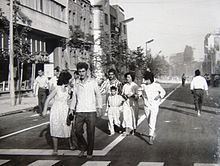
The earthquake, which measured 6.1 on the moment magnitude scale (equivalent to 6.9 on the Richter scale), occurred on July 26, 1963, at 04:17 UTC (5:17 {{nbsp}}am local time) in Skopje, Socialist Republic of Macedonia, then part of SFR Yugoslavia (present-day Republic of Macedonia). The tremor lasted for 20 seconds and was felt mostly along the Vardar River Valley. There were also smaller aftershocks until 5:43.
Aftermath
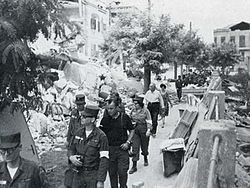
Within days after the earthquake took place, 35 nations requested that the United Nations General Assembly place relief for Skopje on their list of agendas. Relief, in the form of money, medical, engineering and building teams and supplies was offered from 78 countries.
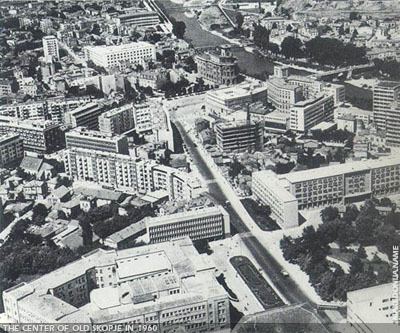
United States president John F. Kennedy ordered the Department of Defense and the Agency for International Development (USAID) to take actions for disaster assistance in Skopje by sending personnel, prefabricated houses, tent cities and other forms of relief. Large amount of relief also arrived from the Soviet Union. Its leader, Nikita Khrushchev, visited Skopje personally. As the SFR Yugoslavia was a member of the Non Aligned Movement during the Cold War, the American and Soviet troops stationed in Skopje could freely shake hands for the first time since their historical encounter on Elbe in 1945.
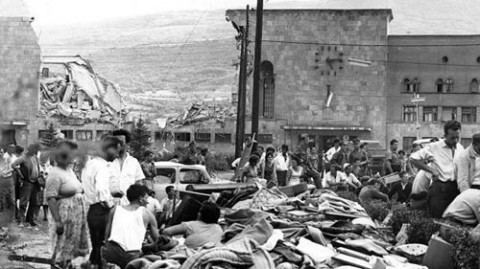
The first foreign journalist who arrived in Skopje to report on the earthquake was David Binder of the New York Times. As he watched Skopje from the plane, he commented that the city looked like it was bombed.

The United Kingdom-based engineer Demetrius Comino provided Dexion building frame materials to enable 49 Royal Engineers to build 1560 dwellings, enough for two complete villages, one of which was nicknamed Dexiongrad. Dexion belongs to the Skopje's Municipality of Gjorče Petrov.
In 1965, the Japanese architect Kenzo Tange was asked by the United Nations to enter a limited competition for the redevelopment of Skopje, after which Tange won 60% of the prize while the Yugoslav team won the remaining 40%. However, Tange's plan for Skopje (one of his major works) remains partly implemented, specifically concerning the New Skopje Railway Station and the so-called City Wall.
As the city gradually began to recover, the need for revival of cultural life arose. The famous artist Pablo Picasso donated his painting Head of a Woman (1963), which was exhibited in the new post-earthquake Contemporary Art Museum of Macedonia. [1] [2] [3] The museum building was a donation from Poland and was designed by several Polish architects. [4] The concert hall "Univerzalna sala" was built with donations from around 35 countries and its prefabricated building was made in neighbouring Bulgaria.[5]
Several streets and objects in Skopje were named in honor of the countries which helped in their construction and/or donated housing. For example, the government of Romania donated the polyclinic medical center, which was named after its capital, Bucharest. In Karposh Municipality, there are soviet-donated apartment buildings called in Macedonian: „руски згради“ (trаnslit.: "ruski zgradi", meaning "Russian buildings") and Swedish and Finnish prefabs called „шведски / фински бараки“ ("švedski / finski baraki").
One example is Skopje's Mexico Street (улица Мексичка, ulica Meksička). It was officially named in honor of the country Mexico and a memorial plaque from the Mexican president Adolfo López Mateos was unveiled at the location. In 2012, the street's well-known resident, the rock musician Vlatko Stefanovski and his brother, the playwright Goran Stefanovski protested against the mayor's decision to rename several city streets, including Mexico Street. The Stefanovski brothers reminded people that the street they grew up on and where the Macedonian rock group Leb i sol was formed was built with donations from Mexico and argued that this act of solidarity must never be forgotten.
Being rebuilt from ruins thanks to the relief from all around the world, Skopje is often referred to as "The City of International Solidarity", which is its motto.
Quotes
Following the earthquake, Josip Broz Tito, then-president of SFR Yugoslavia, sent a message of condolences to the Socialist Republic of Macedonia before visiting the city personally:
Alberto Moravia, one of the leading Italian novelists:
Jean-Paul Sartre, one of the leading figures of the French philosophy and literature:
.
Popular culture
The Skopje Earthquake is referenced in many works of art including literature, music, theatre and films. An example is the Macedonian feature film Memento, directed by Dimitrie Osmanli in 1967. An example from the field of literature is the poem Skoplje 1963 by the Austrian poet Christine Busta.
